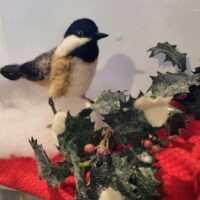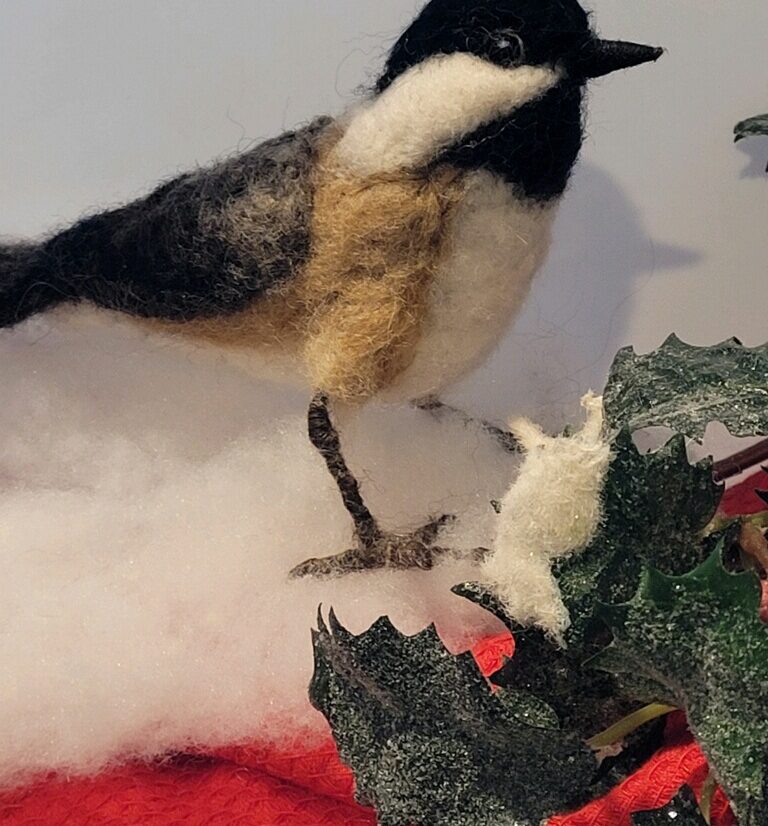Due to high demand – a second session has been added
A bird almost universally considered “cute” thanks to its oversized round head, tiny body, and curiosity about everything, including humans. The chickadee’s black cap and bib; white cheeks; gray back, wings, and tail; and whitish underside with buffy sides are distinctive. Its habit of investigating people and everything else in its home territory, and quickness to discover bird feeders, make it one of the first birds most people learn. Allaboutbirds.com
Come make a needle felted chickadee to either hand on your tree or tuck into greenery on your mantel or other decorations. This adorable chickadee will take several hours to make and can be made by anyone, even those who have had no experience needle felting. Clear step-by step instructions will be given to ensure your chickadee is a success. You will need a small pair of wire cutters, small pair of scissors and needle-nosed pliers. All other materials will be provided and included in the cost of the class.
Gayle Mathues has been needle-felting since 2014. She is a Sarafina Certified Instructor and has a felting business called Animal Faire. She has taught several years at Common Ground on the Hill at McDaniel College. Her specialties are realistic animals and gnome –type figures. Her work can be found at Off Track Art Gallery and at various craft shows throughout the area. Read more about Gayle in the Baltimore Sun article from 2020
TERMS and CONDITIONS: This is an adult only class. Because materials are prepared for each participant, cancellations with refund minus the cost of the materials ($15) will be applied if cancelled within 7 days of the course. Cancellations not accepted within a week of the course date.

Cool Facts about the chickadee – from allaboutbirds.com
- The Black-capped Chickadee hides seeds and other food items to eat later. Each item is placed in a different spot and the chickadee can remember thousands of hiding places.
- Every autumn Black-capped Chickadees allow brain neurons containing old information to die, replacing them with new neurons so they can adapt to changes in their social flocks and environment even with their tiny brains.
- Chickadee calls are complex and language-like, communicating information on identity and recognition of other flocks as well as predator alarms and contact calls. The more dee notes in a chickadee-dee-dee call, the higher the threat level.
- Winter flocks with chickadees serving as the nucleus contain mated chickadee pairs and nonbreeders, but generally not the offspring of the adult pairs within that flock. Other species that associate with chickadee flocks include nuthatches, woodpeckers, kinglets, creepers, warblers and vireos.
- Most birds that associate with chickadee flocks respond to chickadee alarm calls, even when their own species doesn’t have a similar alarm call.
- There is a dominance hierarchy within flocks. Some birds are “winter floaters” that don’t belong to a single flock—these individuals may have a different rank within each flock they spend time in.
- Even when temperatures are far below zero, chickadees virtually always sleep in their own individual cavities. In rotten wood, they can excavate nesting and roosting holes entirely on their own.
- Because small songbirds migrating through an unfamiliar area often associate with chickadee flocks, watching and listening for chickadee flocks during spring and fall can often alert birders to the presence of interesting migrants.
- The oldest known wild Black-capped Chickadee was a male and at least 11 years, 8 months old when it was recaptured and rereleased during banding operations in New York in 2021. It had been banded in the same state in 2009.
Location
6908 Belair Road, Baltimore, 21206



